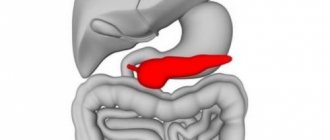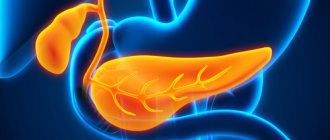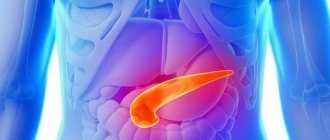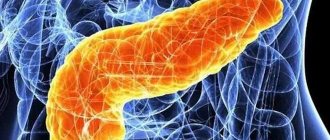Enzymes or enzymes for enzyme deficiency
If we look at the structure of enzymes, they are mainly protein fractions, complex peptides. But it is important to understand that modern science knows about the existence of about 3000 enzymes. These are not only those enzymes that are involved in digestion, but also those enzymes that act during breathing, the work of the cardiovascular system, during the contraction of muscle fiber, etc.
As a result, enzymes or enzymes are catalysts with a protein structure that are formed and function in all cells of a living organism and many times accelerate chemical reactions in different biological environments and tissues without changing their composition.
Enzymes are involved in all metabolic processes that occur in two directions: anabolism and catabolism.
Anabolism is the process of synthesis from simple compounds into more complex ones; as a result of this process, new tissues are created.
Catabolism is a reverse process that leads to the breakdown of complex substances into simpler compounds.
One of the most important areas of enzyme work is the catalysis of digestive processes, as a result of which food components are converted into substances that our body is able to absorb.
Enzymes, basically, either accelerate the breakdown of complex substances (polymers to monomers), or accelerate the formation (synthesis) of complex substances (monomers to polymers). Enzymes are involved in the processes of metabolism, respiration, blood circulation, muscle contraction, nerve impulses... Moreover, the processes take place at the natural body temperature.
Another important property of enzymes is the dependence of their activity on the pH of the environment. Enzymes are most active within the concentration of hydrogen ions, developed in the process of evolution by the physiological value of blood pH - 7.3-7.4. The optimum pH for the activity of digestive enzymes lies within the physiological values of the sections of the digestive tract. For example, pepsin whose pH optimum is in the range of 1.5-2.0. Hydrochloric acid in gastric juice helps convert the inactive form of pepsinogen into pepsin. Enzymes of plant origin are less dependent on the pH environment.
Causes of pancreatic insufficiency
The pancreas produces necessary enzymes, the absence of which can disrupt the entire digestive process.
When the existing substances and enzymes fail, they speak of pancreatic insufficiency.
There are many reasons that can cause this disease:
- damage to gland tissue;
- insufficient amount of vitamins in the human body;
- decreased protein level in the blood;
- significant decrease in hemoglobin;
- unhealthy and unbalanced diet and much more.
This is not a complete list of the causes of glandular insufficiency. There are many factors influencing this disease. By the way, heredity plays a significant role in the occurrence of this disease.
Replenishment of “enzyme reserves” in case of enzyme deficiency
Functional digestive disorders are constant companions of modern man. Pain and heaviness in the stomach, heartburn, flatulence - all this is the price to pay for irregular and unhealthy diet, abuse of fatty foods and alcohol. It is believed that among the urban population, more than 80–90% of residents suffer from various diseases of the gastrointestinal tract.
The process of enzyme synthesis by cells is not unlimited and has a certain limit. Enzymes are sensitive proteins that lose their activity over time. The lifespan of enzymes, in addition to genetic predisposition, is determined by the level and frequency of depletion of enzyme potential in the body. By increasing our dietary intake of natural enzymes, we reduce the depletion of our own enzyme potential.
Evolutionarily, the best way to replenish your “enzyme reserves” involves daily consumption of fresh plant foods. Research in the field of nutrition suggests that per day we should eat 3-5 servings of fresh vegetables and 2-3 servings of fresh fruits, which are a source of enzymes, vitamins and minerals.
Loklo
- Is a source of plant fiber
- Improves intestinal motility and promotes cleansing
- Prebiotic for intestinal microflora
- Reduces cholesterol and blood sugar levels
- Has an oncoprotective effect, binds and removes toxic substances
Application: 1 tablespoon of powder 1 time per day, diluted in 1 glass of cold water. Be sure to drink additional fluids (1-2 glasses).
Main digestive enzymes of the gastrointestinal tract
- in the oral cavity, the breakdown of polysaccharides begins with the help of maltase and amylase;
- the enzymes pepsin, chymosin, which break down proteins and gastric lipase work in the stomach;
- in the duodenum there is lipase, amylase, and trypsin, which breaks down proteins;
- in the small intestine, proteins are fermented by endopeptidases, fatty acids by lipase, sugars by maltase, sucrase, lactase, and nucleic acids by nuclease;
- in the large intestine (provided it is in a normal state), active enzymatic activity of the intestinal flora occurs (breakdown of fiber, immune function).
Complete digestion depends, first of all, on the normal functioning of the pancreas, which synthesizes more than two dozen different enzymes that ensure the digestion and absorption of food.
When creating the human body, nature did not foresee that people would purposefully consume the strongest poisons - alcohol and acetaldehyde (a product of the breakdown of tobacco smoke).
In the liver, there are protective barriers represented by enzymes that break down alcohol, and the pancreas cannot resist the action of aggressive substances. This leads to damage to the structure and function of the organ. However, clinical symptoms do not appear immediately and only in 25–40% of patients.
One of the most common diseases of the gastrointestinal tract - chronic pancreatitis (inflammation of the pancreas) - can be asymptomatic for several years, affecting both people of working age (average age - 39 years) and adolescents.
Tests to assess enzyme levels
Laboratory diagnosis of enzyme deficiency includes
:
- General clinical blood test.
- Blood test for sugar, vitamins and fatty acids,
- Biochemical blood test to determine the level of pancreatic and stomach enzymes: alpha-amylase and pancreatic amylase, lipase, as well as pepsinogen I and pepsinogen II, pepsin.
- Coprogram.
- Elastase immunoassay test (determining the level of elastase-1 in feces).
Classification of enzymes
Based on the type of reactions they catalyze, enzymes are divided into 6 classes according to the hierarchical classification of enzymes. The classification was proposed by the International Union of Biochemistry and Molecular Biology:
- EC 1: Oxidoreductases that catalyze oxidation or reduction. Example: catalase, alcohol dehydrogenase.
- EC 2: Transferases that catalyze the transfer of chemical groups from one substrate molecule to another. Among transferases, kinases that transfer a phosphate group, usually from an ATP molecule, are especially distinguished.
- EC 3: Hydrolases that catalyze the hydrolysis of chemical bonds. Example: esterases, pepsin, trypsin, amylase, lipoprotein lipase.
- EC 4: Lyases that catalyze the breaking of chemical bonds without hydrolysis to form a double bond in one of the products.
- EC 5: Isomerases that catalyze structural or geometric changes in a substrate molecule.
- EC 6: Ligases that catalyze the formation of chemical bonds between substrates through the hydrolysis of ATP. Example: DNA polymerase
As catalysts, enzymes speed up both forward and reverse reactions.
According to their structure, enzymes are divided into:
- simple (protein) produced by the body;
- complex, which usually consist of a protein part and a non-protein substance (coenzyme), which is not produced by the body and must be supplied with food.
The main coenzymes include:
- vitamins,
- vitamin-like substances
- bioelements,
- metals.
According to their functions, enzymes are divided into:
- metabolic (participation in the formation of organic substances, redox processes);
- protective (participation in anti-inflammatory processes and in counteracting infectious agents);
- digestive enzymes of the gastrointestinal tract and pancreas (participation in the processes of breakdown of food and nutrients).
Signs of enzyme deficiency
In the modern world, there is an increase in the number of people with dysregulation and impaired function of the enzyme (enzymatic) systems of the body, which ultimately leads to impaired digestion, fermentation and absorption of ingredients (nutrients) necessary for metabolism with the ensuing consequences:
- an increase in the number of chronic inflammatory pathologies;
- decreased level of specific and nonspecific immunity;
- increase in autoimmune diseases;
- violation of the integrity of cells and tissues.
Signs of enzyme deficiency:
- heartburn
- flatulence
- belching
- headache
- stomach colic
- diarrhea
- constipation
- chronic obesity
- gastrointestinal tract infections.
These symptoms are becoming more common in modern people, and many believe that this is normal. However, they are indicators that the body cannot actively process food.
Due to disruption of the digestive process, diseases of the gastrointestinal tract, liver, pancreas, gall bladder, etc. may occur.
Digestive diseases are one of the main reasons for hospitalization of people. Significant amounts of money are spent on surgeries and hospital treatment. Digestive complaints are more common than other complaints.
Enzyme deficiency
Eating foods that do not contain enzymes negatively affects every stage of the digestive process: direct breakdown of nutrients, absorption, assimilation and excretion. The normal digestive process depends on a balanced diet. Anatomical dissections show that those who constantly eat processed foods have enlarged pancreas that is on the verge of complete destruction.
With poor nutrition, the pancreas must intensively produce digestive enzymes every day throughout life. The gradual wear and tear of the pancreas and other digestive organs does not contribute to their normal functioning and, accordingly, the absorption of necessary nutrients does not occur. This leads to various diseases of both the gastrointestinal tract and other organs.
The importance of the pancreas in ensuring the processes of digestion and absorption of nutrients is extremely high. When a bolus of food (chyme) enters through the pylorus, it triggers the release of pancreatic juice (up to 2 l/day). It contains a complex of digestive enzymes and a sodium bicarbonate solution, which creates an alkaline environment. The maximum concentration of enzymes in the duodenum is reached after 30 minutes. after meals and decreases over the next 3–4 hours.
The quantitative and qualitative composition of pancreatic secretion is relatively unstable and can vary depending on the nature of nutrition. However, normally it contains three main groups of enzymes - proteolytic, lipolytic and amylolytic.
In case of exocrine pancreatic insufficiency:
- Not enough enzymes are produced to digest food.
- Enzymes are not complete in composition (chemical formula).
This leads to impaired absorption of nutrients, weight problems, and conditions associated with a deficiency of protein, bioelements and vitamins.
The main cause of exocrine pancreatic insufficiency is chronic pancreatitis (chronic inflammatory process of the pancreatic parenchyma). This pathology is extremely common and its pathological effect on the body as a whole and the digestive organs in particular is often underestimated.
Pathogenetically, enzyme deficiency is divided into gastrogenic and pancreatic .
Gastrogenic insufficiency , which develops as a result of hypoacid conditions, is caused by a decrease in the secretion of gastric juice and, as a consequence, a secondary decrease in pancreatic secretion. A concomitant complication of gastrogenic insufficiency is the development of pathogenic microflora, which contributes to the inactivation of enzymes in the small intestine.
Pancreatic insufficiency , in turn, is divided into primary and secondary.
Primary pancreatic insufficiency is caused by diseases of the organ and, as a consequence, by the amount of enzymes produced.
Secondary pancreatic insufficiency can be caused by a number of reasons that cause insufficient action of enzymes during their normal secretion:
- cholegenic PN (lipase activation is reduced due to insufficiency of bile acids);
- gastrogenic (insufficient stimulation of the pancreas by gastric juice enzymes);
- enterogenous (caused by microbial contamination of the pancreas and damage to the mucous membrane by endotoxins);
- vascular (occurs when microcirculation in the intestinal wall is disrupted).
Symptoms of enzyme deficiency
| Gastrogen deficiency, overeating | Pancreatic insufficiency |
| Unpleasant sensations (discomfort/pain) in the epigastric region Nausea and vomiting Belching Flatulence Stool disorders Heartburn | Changes in stool character (frequency, polyfecal matter, steatorrhea) Increased intestinal motility Flatulence Change in appetite |
The most common cause of digestive problems is dietary errors - eating too much food and its “heavy” chemical composition. Often a large feast is accompanied by the consumption of significant doses of alcohol, which disrupts the functioning of the pancreas. In this case, despite the adequate secretion of enzymes and their normal activity, symptoms similar to gastrogenic insufficiency occur in the human body.
Digestive insufficiency is dangerous because part of the incoming food remains unchanged in the intestinal cavity. This leads to a change in the internal environment of the intestine (shift in acidity, chemical composition, osmotic pressure). This causes damage to the intestinal mucosa and the development of pathogenic microflora.
An obligatory companion to digestion disorders is:
- a sharp decrease in absorption (malabsorption);
- insufficient intake of fats, proteins, carbohydrates, vitamins, iron, etc. into the body...
The problematic thing is that diarrhea does not occur until the gland has lost 80-90% of its physiological capabilities, that is, the disease can occur without visible symptoms for some time.
The main factor in the prevention of pancreatic diseases is good nutrition and the absence of bad habits. Fatty foods and alcohol intake lead to increased production of digestive enzymes and damage to the pancreas. For the normal functioning of the gastrointestinal tract, boiled or baked foods, cereals, lean meat and fish, various soups and lactic acid products are of undoubted benefit. It is advisable to exclude strong black tea, coffee and sugar. It is better to divide all food into several frequent meals.
In chronic pancreatitis, the pancreatic parenchyma is replaced by connective tissue and this leads to a decrease in the synthesis of enzymes. Then even familiar food products cannot be fermented (degraded), which leads to various deficiency states of essential nutrients, and as a consequence, poor functioning of the immune system, autointoxication, increased antigenic load on the body, decreased quality of life, and rapid pathological aging.
Correction of exocrine insufficiency with high-quality enzyme products from NSP (Digestive Enzymes and Protease Plus) is an effective measure for various pathological conditions of the pancreas, where additional enzyme intake is required to normalize the functioning of the gastrointestinal tract and the body as a whole. In addition to enzymes, these products also contain herbal active ingredients , promoting more complete fermentation and absorption of food, which helps to perform those functions that the pancreas is no longer capable of and, over long years of life, to compensate for the insufficiency of the enzyme system and help in the absorption of food ingredients.
Digestive enzymes
- Replenishes deficiencies of digestive enzymes
- Improves breakdown and absorption of nutrients
- Normalize the functioning of the gastrointestinal tract
- Regulates the level of hydrochloric acid in the stomach
- Normalizes the microflora of the gastrointestinal tract
- Have an anti-inflammatory effect
- Regulate acid-base balance
Digestive Enzymes dietary supplement from NSP is an optimal combination of highly active enzymes of plant and animal origin, hydrochloric acid in the form of betaine hydrochloride, which promote the breakdown and absorption of all nutrients.
Replenishes the deficiency of basic enzymes, it is recommended for use not only by patients, but also by healthy people, especially the elderly, and is used for various fermentopathy, antacid and hypoacid gastritis, biliary dyskinesia, allergic diseases, dysbiosis.
Application: as a dietary supplement for adults, take 1-2 capsules 3 times a day with meals.
Store in a dry, cool place, protected from light.
Composition of the 1st capsule “Digestive Enzymes”:
- Bromelain – 50 mg,
- Betaine hydrochloride – 162 mg,
- Lipase - 0.5 mg,
- Amylase – 90 mg,
- Ox bile extract – 40 mg,
- Papain – 45 mg,
- Pepsin – 60 mg.
- Pancreatin - 22.5 mg: protease activity - 300,000 units. in a capsule,
- amylase activity – 30,000 units. in a capsule,
- lipase activity – 15,000 units. in a capsule.
Pancreatin is used for:
- pancreatic enzyme deficiency,
- cystic fibrosis,
- digestive disorders,
- food allergies,
- autoimmune diseases,
- viral infections,
- sports injuries.
Bromelain - obtained from pineapple, breaks down proteins and fats, has anti-inflammatory and immunocorrective effects, reduces swelling and inflammation, heals wounds and trophic ulcers, helps cleanse wounds of necrotic tissue, regenerating agent. Bromelain is a concentrated mixture of proteolytic (lipolytic) enzymes (proteases, peptidases). Bromelain is effective in a wide pH range and is active in both slightly acidic and neutral, slightly alkaline environments, which is important. For example, gastric pepsin is active only in an acidic environment and with low acidity (in elderly people) it already loses its activity.
Papain, or plant pepsin, is an enzyme that breaks down proteins. Contained in papaya, pineapples, bananas, melon tree juice, kiwi fruits, mangoes. It is obtained from these fruits for medicinal purposes. Papain is capable of breaking down lean meat 35 times its own molecule weight, and digests egg albumin, the amount of which is 300 times its own weight. Destroys toxins of many pathogens of infectious diseases, including tetanus. Papain is a broad-spectrum enzyme that ferments proteins to a state in which they can be easily digested. This property of papain is indispensable for people suffering from adhesive disease after surgery, which has allowed papain to gain the reputation of a “biological scalpel.”
Pepsin is a proteolytic enzyme contained in gastric juice that “works” only in an acidic environment. Trypsin, another digestive enzyme, works only in an alkaline environment. But papain is active in acidic, alkaline, and neutral environments. This provides papain with an important place in the treatment of diseases with gastrointestinal acidity disorders.
Modern man needs additional, natural enzyme forms as dietary supplements. Plant enzymes do not affect the production of the body's own digestive enzymes and do not replace them . The pancreas simply receives additional help without reducing enzyme production. Plant enzymes are more stable over a wide range of pH and temperatures. The stomach environment is very acidic, while the small intestine environment is more alkaline. Plant enzymes can work effectively in both the stomach and intestines.
The great advantage of plant enzymes is that they can pre-digest food in the stomach before the food ever reaches the small intestine where it can be absorbed. When digested in the small intestine, even if it is damaged (inflammation, dysbiosis or helminthic infestation), pre-fermented food is much less likely to cause negative reactions. It is much more likely that the nutrients will be absorbed in the intestines and used to nourish the body.
Functions of the organ
The pancreas is a small organ located above the intestines and opens into the duodenum.
It is an organ of mixed secretion because it has:
- intrasecretory function, producing insulin that enters directly into the blood and regulates the absorption of glucose;
- exocrine function, which consists in the production of enzymes involved in digestion.
A special juice is formed in the pancreas, containing, in addition to enzymes, water, minerals, mucus and bicarbonates, which neutralize the acidic environment of the stomach. Enzymes entering the intestines through the ducts of the gland are activated by bile released from the gallbladder.
The main enzymes produced by the pancreas are:
- lipase;
- amylase;
- protease;
- maltase;
- lactase.
The first helps break down fats, the second helps break down carbohydrates, and the third helps break down proteins into a form that can be absorbed into the blood. Maltase and lactase act on less common carbohydrates: maltose and lactose. Enzymes are specific and do not activate the process of breaking down another substance. However, their operation requires a certain reaction from the environment. It must be alkaline; if this condition is not met, the substances will be inactive.
Determining which enzymes the pancreas needs to produce is the prerogative of the gland itself. Receptors in the stomach and intestines recognize the composition of food, transmit this information to the brain, and from there it enters the working organs, including the gland, which begins to produce the corresponding substance.
Proteolytic enzymes
Enzymes are an integral part of any biochemical reaction that occurs in the body. The very meaning of the word enzymes is usually identified with the process of digesting food in the gastrointestinal tract. Enzymes also provide redox processes, energy storage, oxygen absorption, and also carry out certain metabolic processes inside each cell and have a protein structure.
With age, our body produces fewer and fewer enzymes, the synthesis of which can also be affected by harmful environmental factors, infections, and deficiency conditions (lack of protein, microelements, vitamins in food). If incomplete digestion of protein molecules occurs in the intestines, then their fragments are absorbed into the blood, disrupting not only metabolic processes, but also negatively affecting the immune system.
Proteolytic enzymes play a key role in metabolism and especially in such important body functions as:
- immunological reactions,
- vascular tone,
- intercellular interaction,
- blood clotting,
- fibrinolysis, etc...
In recent years, enzyme and multienzyme products have been widely used in medical practice, which are used topically and for the treatment of diseases of the digestive system. The therapeutic effect of proteolytic enzymes during resorptive action has not been sufficiently studied, since for a long time it was believed that these enzymes act mainly in the digestive canal.
One of the main questions of systemic enzyme therapy: what is the degree of resorption (absorption) of proteolytic enzymes in the intestine and their effect on various organs and systems of the body?
Some of the enzymes that have not passed the intestinal barrier are included in the digestion process, regulating the function of the stomach, intestines, liver, pancreas, and other organs. A certain amount of proteolytic enzymes contained in NSP enzyme products circulating in the blood can enter the intestines through the enteropancreatic circulation.
In complex therapy of various diseases, proteolytic enzymes are successfully used, which leads to a reduction in treatment time. Their effectiveness is due to the expressed:
- anti-inflammatory,
- decongestant,
- immunomodulatory,
- fibrinolytic,
- necrolytic,
- painkillers,
- hypolipidemic,
- antioxidant effect.
Enzymes improve regional microcirculation.
Breakdown and absorption of proteins
Protease Plus enhances protein fermentation processes in all structures and tissues of the body, including food digestion. The composition includes not only a highly active protease enzyme, but also a micromineral complex obtained from plant sources.
Immunity
Protease Plus activates macrophages and immune killer cells, which justifies the use of the complex in immunodeficiency conditions and oncology.
Enzyme products do not cause any significant side effects and can be used in high doses for a long time at all stages of the development of malignant neoplasms - from prevention, to supporting the body during chemotherapy or radiation, as well as alleviating the condition of patients in the terminal stage.
With enzyme therapy:
- Liver function is normalized;
- Fibrinolysis improves;
- Microcirculation improves;
- Antitumor immunity is activated;
- The concentration of cytokines is normalized;
- The effectiveness of radiation and chemotherapy increases, while simultaneously reducing their negative impact;
- The number of pathological autoimmune complexes is reduced by destroying them.
Products for systemic enzyme therapy exhibit a therapeutic effect in atherosclerosis, elastase activity increases, and the structure of collagen and elastic structures is restored. The anti-atherosclerotic effect of enzymes is associated with the effect on metabolism in the connective tissue of arterial vessels. Systemic enzyme therapy prevents metabolic damage to the myocardium and prevents the formation of fibrosis in myocarditis.
Methods for diagnosing pathologies
To diagnose the functional state of the pancreas, biochemical and instrumental research methods are used.
In addition, liver functions are determined - bilirubin, transaminases, total protein and its fractions, blood glucose.
The presence of amino acids is detected in the urine.
To detect phenylketonuria, a congenital pathology of the pancreas, the determination of phenylalanine in the blood is used. These tests are performed in maternity hospitals on all newborns on days 4–5 of life. According to WHO recommendations, the pathology is included in the list of hereditary diseases recommended for early diagnosis.
Celiac disease is detected by serological diagnostic methods with the determination of antibodies and antigens for gluten intolerance.
Lactase deficiency is confirmed by the results of blood tests and analysis of the lactose curve: lactose stimulation is carried out - the patient is given lactose in a small dosage, then the blood is tested. The level of lactose in the urine is also determined, where it enters in small quantities.
Instrumental research methods are used for differential diagnosis and exclusion of organic damage to pancreatic tissue or the presence of stones, cysts, and inflammatory processes. Conducted:
What tests are needed to determine enzymes?
Blood and urine tests are studied for the activity of the main enzymes:
A coprogram in the presence of undigested muscle fibers, fats, and starch particles indicates insufficient enzyme content.
The main indicator when studying stool analysis is elastase. Reducing it can help cure the disease and make the digestive organs function normally.
Systemic enzyme therapy for enzyme deficiency
Systemic enzyme therapy for enzyme deficiency:
- normalizes lipid metabolism and immune system function,
- improves the condition of patients,
- reduces the development of complications in pathologies of the cardiovascular system,
- reduces the number and intensity of pain attacks,
- increases tolerance to physical activity,
- reduces initially elevated values of blood and plasma viscosity parameters, fibrinogen levels, aggregation ability of erythrocytes and platelets,
- enhances fibrinolysis.
The complex regulatory effect of NSP's enzyme products on the cardiovascular and immune systems, liver function, digestive organs, blood clotting and fibrinolysis is characterized by polytropy, which is due to the presence of different ingredients with enzymatic action in the product.
Increasing the antitoxic function of the liver, normalizing the coagulogram, and antioxidant activity are important in demonstrating the medicinal properties of systemic enzyme therapy products for various inflammatory and other diseases.
The data presented allow us to state that the therapeutic effect of proteolytic enzymes lies in their regulatory effect on the functions and metabolism of the body, in increasing its resistance to external negative factors.
Systemic enzyme therapy for pathologies
- Coronary heart disease, post-infarction syndrome.
- Inflammation of the upper and lower respiratory tract, sinusitis, bronchitis, bronchopneumonia, pancreatitis, cholecystoangiocholitis, ulcerative colitis, Crohn's disease.
- Rheumatoid arthritis, extra-articular rheumatism, ankylosing spondylitis, Sjogren's disease.
- Lymphoedema, acute superficial and deep thrombophlebitis, postthrombotic syndrome, vasculitis, thromboangiitis obliterans, prevention of recurrent thrombophlebitis, secondary lymphedema.
- Pre- and postoperative inflammatory processes, post-traumatic edema, plastic and reconstructive surgeries.
- Acute injury, post-traumatic swelling, fractures, dislocations, soft tissue bruises, chronic post-traumatic processes, prevention of the consequences of injuries in sports medicine.
- Acute and chronic urinary tract infections, adnexitis, mastopathy.
- Multiple / multiple / sclerosis.
Protease Plus
- Restores deficiency of proteolytic enzymes
- Improves the breakdown and absorption of proteins
- Normalizes the microflora of the gastrointestinal tract
- Has anti-inflammatory and anti-edema effects
- Has an immunomodulatory effect
- Improves regional microcirculation and accelerates regeneration processes
- Effective in use for systemic enzyme therapy (SE).
Compound:
A mixture of proteolytic enzymes (proteases) of varying activity - 203 mg
Other ingredients: Beet fiber - 197 mg Bentonite - 100 mg Protease activity - 60,000 units/capsule
Recommendations for use: to improve digestion, take 1 capsule with meals.
For anti-inflammatory therapy and immunocorrection, take 1-3 capsules between meals 3-4 times a day.
Enzyme therapy with Protease Plus for enzyme deficiency
The processes of tissue destruction and restoration in various destructive diseases also occur with the participation of proteolytic enzymes.
Therefore, the use of the Protease Plus complex is recommended for:
- Diseases associated with cartilage destruction (arthrosis, arthritis, osteochondrosis)
- Purulent and inflammatory diseases (bronchitis with copious sputum, pleurisy, wound suppuration, trophic ulcers, etc.)
The use of systemic enzyme therapy in the treatment of patients with diabetic foot syndrome reduces the incidence of necrotic complications several times, and, consequently, indications for amputation.
Modern treatment of chronic prostatitis (especially prolonged cases) involves the use of systemic enzyme therapy.
AG-X
- Stimulation of enzyme production
- Fight inflammation in the digestive system
- Relief of pain and spasms of the gastrointestinal tract
- Increased secretion of the digestive glands
- Improving food digestion in the gastrointestinal tract
- Increasing the body's protective properties
AG-X capsule contains:
- papaya fruits,
- ginger root,
- peppermint leaves,
- wild yam root,
- fennel,
- catnip,
- dong qua root,
- lobelia herb (only in the formula in Ukraine),
- spearmint.
Papaya contains papain, a plant enzyme that catalyzes the hydrolysis of proteins. Rich in organic acids that normalize the digestive process. Promotes rapid regeneration of mucous membranes.
Ginger stimulates the production of digestive juices and bile, promoting food absorption.
Wild yam reduces blood cholesterol and lipid deposition in arterial vessels and the liver.
Fennel has a choleretic, analgesic, antispasmodic effect. Increases the secretion of digestive juices. Improves the secretory functions of the gastrointestinal tract. Regulates the motility of the stomach and intestines.
Angelica Chinese (Dong Qua) stimulates the secretion of pancreatic juice; good choleretic. It has antimicrobial properties, suppressing the processes of fermentation and putrefaction in the intestines. Strengthens intestinal motility.
Lobelia contains rutin, vitamin C, fatty acids, tannins, iodine, etc. A strong antispasmodic.
Peppermint has an antispasmodic and mild anesthetic effect, causing increased peristalsis. Limits the processes of rotting and fermentation in the stomach and intestines.
Catnip is used for colitis, gastritis and other gastrointestinal diseases, stomach atony, and increases appetite.
All medicinal plants AG-X contain magnesium, manganese, phosphorus and other bioelements, vitamins A, C and group B.
Magnesium salts activate enzymes that participate in the transformation of organic phosphorus compounds. Magnesium is involved in carbohydrate metabolism and protein biosynthesis. Regulates the acidity of gastric juice and appetite. In the presence of pyridoxine (vitamin B6), it promotes the dissolution of kidney and gallstones.
Manganese, as a component of a large number of enzymes, counteracts fatty liver degeneration. If there is a lack of manganese in the body, protein and fat metabolism, blood sugar levels, etc. are disrupted.
Organic phosphorus compounds are genuine accumulators of energy released during the process of biological oxidation. It is in the form of phosphorus compounds that energy is used by the body in biochemical processes occurring in the liver, kidneys...
Riboflavin (vitamin B2) is used for disorders of the gastrointestinal tract, hepatitis and other liver diseases. Removes heavy metal salts from the body. Promotes the healing of ulcers (including chronic ones) and wounds.
Many enzymes are metalloenzymes. Metals form complex complexes with proteins, where they are the active center. A deficiency of bioelements leads to a loss of overall enzymatic activity.
Colloidal Minerals with Acai Juice
Dietary supplement Colloidal minerals with Acai juice contains a concentrated complex of 74 macro- and microelements.
The greatest quantities contain: magnesium, iron, selenium, manganese, chromium, sodium, zinc. Contains fulvic acid. This is a complex of humic substances that convert minerals into chelate compounds, which increases their digestibility.
The formula contains Acai berry juice, as well as grape skin extract containing flavonoids. Acai berries contain various biologically active substances, vitamins, microelements, sterols and antioxidants (flavonoids, cyanidins).
Important: enzyme systems do not work without the normal supply of our body with nutrients (vitamins, minerals).
I wish you to be healthy and beautiful!
Recommendations of nutritionist Salo I.M.
The full recording of the material on the topic “Correction of enzyme deficiency with NSP products” can be listened to below:
Diagnostics
To determine whether a person has a deficiency of digestive enzymes or not, various diagnostic methods are used, which include:
- probe and probeless tests;
- ultrasonography;
- X-ray examination;
- endoscopy.
The most informative in this matter are probe tests. However, they are very expensive and cause a lot of discomfort to the patient during their implementation. Probeless tests are painless for humans and are much cheaper, but they cannot detect enzyme deficiency in the initial stages of its development. Such tests make it possible to diagnose a disease accompanied by a significant decrease in the synthesis of pancreatic enzymes or their complete absence.
Most often, a direct probe secretin-cholecystokinin test is used to diagnose enzyme deficiency. Its essence is to stimulate the production of pancreatic enzymes through the introduction of special substances - cholecystokinin and secretin. Then laboratory tests of the obtained material are carried out for the activity and rate of enzyme secretion. Additionally, the concentration of bicarbonates is determined.
If there are no disturbances in the exocrine functions of the gland, the increase in secretion volume is 100%, and the concentration of bicarbonates does not exceed 15%. If these indicators are much lower than normal, then in this case we are already talking about the development of enzyme deficiency.
Probeless tests are carried out as follows:
- first they take a urine and blood test, and then examine it;
- then certain substances are introduced into the body, which react with enzymes present in the urine and blood;
- repeat tests are taken;
- compare the results.
Among these diagnostic methods, the most popular are:
- iodolipol test;
- bentiramide test;
- triolein test;
- pacreato-lauryl test.
In addition to the tests, a coprogram is carried out, which allows you to determine the degree of absorption of pancreatic amino acids, the level of fat, trypsin and chymotrypsin in the stool.
If the results of these examinations reveal an enzyme deficiency, computer diagnostics (ultrasound, MRI, CT) are prescribed, with the help of which the main or concomitant deficiencies of the disease are identified.











